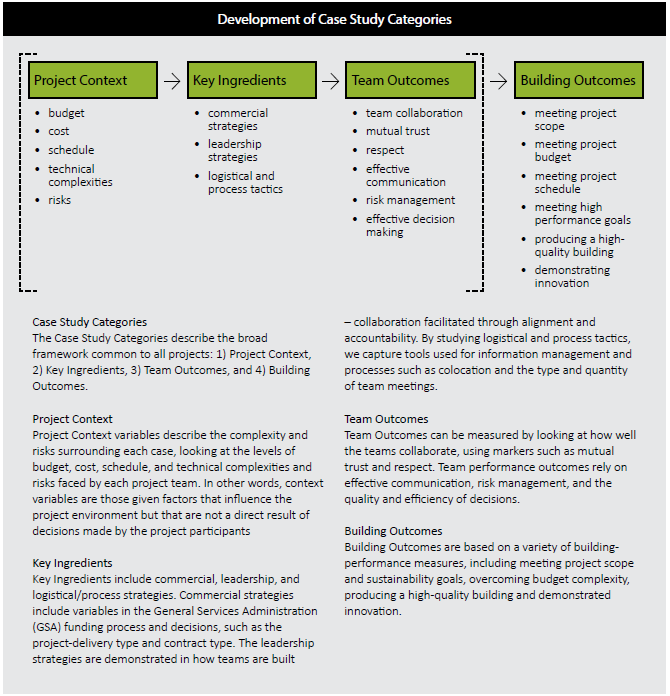Methodology
Research goal
This study examines the collaboration processes of three recently completed GSA projects to link high-performance outcomes with integrated decisions made during the design and construction processes. The study focused on economic impacts and risk assessment, and includes an assessment of related performance-based contracting provisions.
The findings of this study support the use of collaboration processes on future projects. We seek to influence improvements to government procurement processes and offer lessons learned for project teams seeking to implement integrated processes and performance contracting.
Development of Case Study categories
The research team has experience with several studies on integrated project delivery, high-performing buildings, and collaborative practices. For the analysis of the cases in this report, we adapted Case Study Categories from prior studies: context, key ingredients, team outcomes, and building outcomes. This framework functioned as a guide for data collection and was refined throughout our research.

The presentation of this report follows the framework established by the Case Study Categories. Categories identified by the research team as key ingredients are organized as horizontal bars along the top of each panel. Tabs for specific topics are grouped beneath those bars. Tabs running on the vertical axis help the viewer navigate the three cases as well as compare the cases. Team Outcomes are integrated into the text under a variety of topics. Building Outcomes are addressed in the High Performance category, and the Building Innovation category provides specific examples from each project.
Category tabs
The Overview section describes the factual information about each project as well as the contextual factors contributing to the development of the program, site, budget, and schedule, including the constraints and goals of the American Recovery and Reinvestment Act (ARRA). This section includes team organization and a timeline of each project’s milestone events alongside ARRA milestones.
The High Performance section describes how building outcomes for each project compare with industry conventions, such as those of LEED. Tabs under each project describe the specific technologies used to achieve the outcomes.
Commercial Strategies includes a range of issues related to procurement: how the GSA developed the request for proposals (RFP), the process of team selection, relevant contract terms, and creation of a verification phase post occupancy.
Leadership Strategies includes how the collaborative culture was created through intentional team building; how leaders defined goals, communicated them, and achieved alignment with them; how roles were defined; and how leaders established accountability within the teams.
Logistical and Process Tactics describes how decisions were made, communicated, and tracked. We included Building Information Modeling (BIM) and design documentation strategies and the ways that meetings were scheduled and tracked as well as the physical environment of the formal and informal interactions between team members and stakeholders. The GSA peer review process is a separate category used to describe the timing, effectiveness, and ways the process was leveraged.
For more information on the research methodology, visit the “Research Methodology” section of the Case Study [PDF - 14 MB].

 U.S. General Services Administration
U.S. General Services Administration